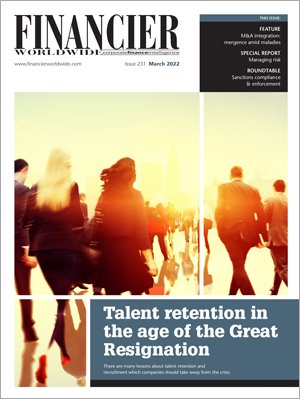Interagency roadmap: is 2022 the year of crypto regulation?
March 2022 | FEATURE | BANKING & FINANCE
Financier Worldwide Magazine
On 23 November 2021, federal bank regulatory agencies in the US – namely the Federal Reserve Board, the Federal Deposit Insurance Corporation and the Office of the Comptroller of the Currency – issued a statement summarising their interagency ‘policy sprints’ focused on crypto-assets and providing a roadmap of future plans. This was the first indication by US banking regulators — as opposed to the Securities and Exchange Commission (SEC) — of a crackdown on crypto-assets.
The roadmap summarises the agencies’ plan to provide greater clarity throughout 2022 on whether certain crypto-related activities conducted by banking organisations are legally permissible. It outlines their expectations for safety and soundness, consumer protection and legal and regulatory compliance.
The key issues include crypto-asset safekeeping and traditional custody services, ancillary custody services, facilitation of customer purchases and sales of crypto-assets, loans collateralised by crypto-assets, issuance and distribution of stablecoins, activities involving the holding of crypto-assets on balance sheets, and bank capital and liquidity standards including related engagement with the Basel Committee on Banking Supervision.
Cooperation between three such agencies is rare in the US but indicates the rising importance of cryptocurrency within the global economy. It is a market now worth over $3 trillion, according to CoinGecko, with continued growth expected in the years ahead.
2021 saw more mainstream adoption of cryptocurrencies, heightening calls for regulation. While regulation has been anticipated for some time, 2022 may be the year it finally lands.
Stablecoins
One area of cryptocurrencies in the crosshairs is stablecoins. A form of digital currency issued and traded on blockchains, stablecoins are pegged to a ‘stable’, tangible asset such as gold, reserve currencies or government bonds. Thanks to their pegged value, stablecoins aim to offer a less volatile, more reliable asset safe-haven for crypto users.
“The roadmap summarises the agencies’ plan to provide greater clarity throughout 2022 on whether certain crypto-related activities conducted by banking organisations are legally permissible.”
The market value of stablecoins has surged from $24bn to $140bn in recent years, with much of that growth concentrated in a handful of coins. A market that large has regulators increasingly worried. “Stablecoins can certainly be a useful, efficient consumer serving part of the financial system if they’re properly regulated,” said Jerome Powell, chairman of the Federal Reserve.
Stablecoins are perhaps the easiest forms of cryptocurrency to regulate and potentially the greatest threat to consumers due to the potential loss of value or access to the initial investment. A report prepared by the President’s Working Group on Financial Markets outlined the potential risks that stablecoins might pose to “market integrity and investor protection”, such as “possible fraud and misconduct in digital asset trading, including market manipulation, insider trading, and front running, as well as a lack of trading or price transparency”.
There are certainly areas of concern. Primarily, stablecoins lack investor protections, such as Federal Deposit Insurance Corporation (FDIC) insurance, if losses do occur. Some stablecoins are backed by commercial bonds, which may lose value or prevent investors from cashing out. A decrease in the value of the pegged asset could keep stablecoin issuers from meeting holders’ redemption demands. They may be susceptible to liquidation runs if investors drain their accounts all at once. Finally, there are suggestions that stablecoins could be perceived as competing with the US dollar.
But the impending US mid-term elections may have a bearing on the timeline for any potential crypto-related regulations. The topic is not widely considered a major campaign issue that will sway voters, so it could be shelved. The Biden administration may de-prioritise progress on crypto regulations until after the crucial mid-term elections. And if new laws are not introduced, authorities will have to rely on existing regulations which are likely to prove insufficient in the long term.
International approach
Internationally, countries are adopting varying approaches to cryptocurrency regulation. In India, the government has chosen to ‘fast track’ crypto regulation, while other developing markets such as Brazil and Russia are still considering the best way forward.
In January, the UK government took preliminary steps by announcing that companies will be banned from promoting crypto assets such as bitcoin unless they are registered with the financial regulator. Later this year, the UK government is also expected to receive the results of a separate consultation on what the overarching framework for crypto regulation should look like.
However, one of the biggest complications for crypto regulation is jurisdiction. A feature of cryptocurrency is that it is difficult to accurately ascertain the location of a ledger. As such, the nodes associated with any crypto deal may be situated across different jurisdictions and therefore subject to different and potentially conflicting legal frameworks. The cross-border nature of blockchain technology also makes it difficult to select the ‘correct’ jurisdiction for blockchain disputes. National regulators will need to address these challenges.
Given the direction of travel, it would behove companies in the cryptocurrency market to take appropriate measures, such as consulting legal experts and appointing compliance officers. It seems that greater regulatory oversight may finally be on the cards.
© Financier Worldwide
BY
Richard Summerfield


